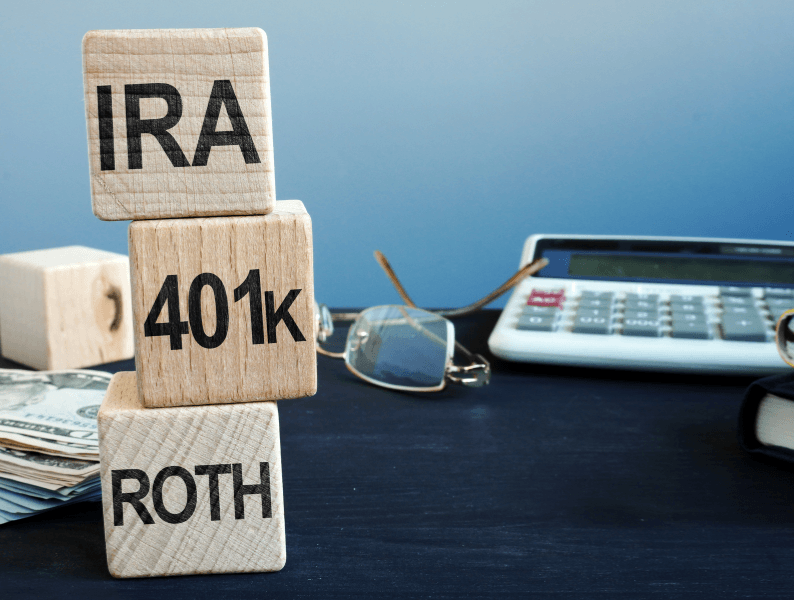Secure Act 2.0 Explained: Transforming Your 401k & Retirement Planning
Last Updated on April 15, 2024 by VantagePoint
The start of a new year presents an excellent chance to enhance your retirement savings. A 401k plan is a retirement savings plan provided by an employer to its eligible workers. This plan allows for payroll deductions to be made either before taxes, following the traditional 401k plan format, or after taxes, as seen in the Roth 401k plan approach.
What we’ll discuss:
- What is Secure Act 2.0?
- What changes to expect in 2024 under the Secure Act 2.0
- Key takeaways
- 401(k) Contribution Limits
- Contribution limits for IRAs
- Deciding on the right retirement account for your contributions
- SECURE 2.0: Tax Credit Opportunities for Small Business 401(k) Plans
What is Secure Act 2.0?
In 2019, Congress approved the Setting Every Community Up for Retirement Enhancement Act (SECURE Act) to assist Americans in better planning for their retirement. At the end of 2022, legislation known as the SECURE 2.0 Retirement Savings Act, or “SECURE Act 2.0,” was enacted, building upon the original 2019 SECURE Act and further enhancing the retirement savings infrastructure. The new legislation is aimed at significantly enhancing retirement savings opportunities, including 401(k) and 403(b) plans, making it easier for small businesses to offer retirement benefits to employees and for individuals to save and prepare for the future.
What changes to expect in 2024 under the SECURE 2.0 Act
The Secure 2.0 Act marks 2024 as a significant year with the introduction of multiple regulations. Whether you’ve already entered retirement, are nearing retirement, or retirement is still several years ahead, the amendments to the SECURE Act are likely to impact you to some extent.
This advanced retirement legislation initiates a gradual implementation of some of the broadest modifications to the ERISA framework seen since 1974. Given the extensive developments, effective communication and adherence to these new regulations are crucial for navigating and effectively applying the latest phase of the Secure Act 2.0.
Employers have historically found it difficult to encourage contributions to retirement plans, especially from younger employees. However, the Secure 2.0 Act of 2022 presents an opportunity for employers to not only assist employees in boosting their retirement savings but also to enhance the benefits of 401(k) plans for workers of all ages and income levels.
By raising your contributions to 401(k) plans or IRAs, you can increase your retirement savings, but it’s important to keep in mind the existing contribution limits. Contribution maximums for both employer-sponsored and individual retirement accounts are established annually by the IRS.
Key Takeaways:
- For 2024, the maximum amount employees can allocate to their 401(k) plans is $23,000, an increase from $22,500 in 2023.
- Individuals aged 50 and above can make an extra catch-up contribution of $7,500 in both 2024 and 2023.
- The combined maximum limit for contributions from both employer and employee in 2024 is set at $69,000, or $76,500 when including the catch-up contribution.
- In 2023, the total contribution limit for both employer and employee was $66,000, reaching $73,500 with the catch-up addition.
- Contribution limits for retirement plans are reviewed and adjusted yearly by the IRS to account for inflation.
- Starting in 2024, individuals will have the option to withdraw up to $1,000 annually from their retirement savings to address personal or family emergencies without incurring penalties. This means there will be no additional fees or taxes levied on these withdrawals.
- Starting in 2024 as well, employers will have the option to provide automatic enrollment for employees in an emergency savings account, with a maximum of $2,500. These funds will be associated with your retirement plan but will not face the penalty taxes applicable to withdrawals from your retirement account.
- Beginning in 2024, employers can make matching contributions to 401(k), 403(b), or SIMPLE IRA plans for employees’ qualified student loan payments. This initiative allows those with student loans to simultaneously pay off their debt and accumulate retirement savings, without having to choose between the two.
401(k) Contribution Limits for 2024
Maximizing the 401(k) plan can be a straightforward and powerful strategy for retirement savings. But 401(k) plans have contribution limits. These plans allow you to automatically allocate a part of an employee’s salary to retirement savings, but there’s a cap on how much you can contribute.
Standard contribution
For 2024, the standard contribution cap for employees to 401(k) plans is set at $23,000, up from $22,500 in 2023. This encompasses elective deferrals from employee salaries and any amounts contributed to designated Roth accounts or Roth 401(k) plans.
Individuals aged 50 and above are allowed a catch-up contribution of $7,500, identical to the 2023 allowance, leading to a possible total of $30,500 in contributions (compared to $30,000 in 2023).
These limits are also applicable to 403(b) plans, the majority of 457 plans, and the federal Thrift Savings Plan. Holders of multiple 401(k) accounts, both traditional and Roth, must ensure their combined contributions do not surpass the $23,000 threshold. Contributions to other retirement accounts like IRAs do not impact the 401(k) contribution limit.
After-tax contributions
For individuals with the capacity to save beyond the basic limits and whose employers provide the option, after-tax contributions to a 401(k) are a viable choice. In 2024, the aggregate limit for contributions, which includes elective deferrals by employees, after-tax contributions, and any employer contributions, is set at $69,000. For those aged 50 and older, this limit increases to $76,500. The previous year, 2023, had a total limit of $66,000, with an increased threshold of $73,500 for those 50 or older.
The IRS facilitates additional savings for individuals nearing retirement by permitting those aged 50 and above to exceed the standard contribution caps, enhancing their opportunity to build up tax-advantaged retirement funds.

Employer Contributions
A significant advantage of enrolling in a 401(k) plan is the potential for employer contributions. It’s common for employers to match the amounts employees contribute, sometimes adding 50 cents or even a dollar for every dollar that the employee saves.
Additionally, employers have the option to contribute to employees’ 401(k) plans through elective contributions without being influenced by the amount the employee contributes, subject to maximum limits. For the year 2024, the cap on combined contributions from both the employer and employee is $69,000. This cap increases to $76,500 with the inclusion of the $7,500 catch-up contribution for those aged 50 and older.
Assessing your projected contributions for the upcoming year and reviewing your contributions after the calendar year ends is crucial. Should you discover that your contributions have surpassed the yearly maximums, the IRS mandates that any excess amounts be refunded to you by April 15.
Should you need help updating your retirement plan or agreement according to the new provisions of SECURE Act 2.0, or if you have inquiries about the impact of SECURE 2.0 and its related guidelines on your plan, please reach out.
The following table outlines the changes in regulations and maximum contribution limits for defined-contribution plans (including 401(k), 403(b), and most 457 plans, comparing 2024 to 2023.
| Defined Contribution Plan Limits | 2024 | 2023 | Change |
| Maximum employee elective deferral | $23,000 | $22,500 | +$500 |
| Employee catch-up contribution (if age 50 or older by year-end)* | $7,500 | $7,500 | +$0 |
| Defined contribution maximum limit, all sources | $69,000 | $66,000 | +$3,000 |
| Defined contribution maximum limit if age 50 or older by year-end; all sources, plus catch-up | $76,500 | $73,500 | +$3,000 |
| Employee compensation limit for calculating contributions | $345,000 | $330,000 | +$15,000 |
| Key employees’ compensation threshold for nondiscrimination testing | $220,000 | $215,000 | +$5,000 |
| Highly compensated employees’ threshold for nondiscrimination testing | $155,000 | $150,000 | +$5,000 |
Subscribe to the VantagePoint Newsletter! Financial wisdom is crucial — so take full advantage. Receive expert advice, strategic insights, the latest news, and all you need to optimize your finances, directly in your inbox. Subscribe now.
Contribution limits for IRAs
With the introduction of the new act, starting from December 31, 2024, employers will need to automatically enroll employees into any newly established 401(k) or 403(b) retirement plans.
This new regulation will not apply to everyone. Retirement plans sponsored by the government, religious institutions, businesses that are less than three years old, and businesses with 10 or fewer employees will not be subject to this rule.
In 2024, the combined contribution limit for both traditional and Roth IRAs was raised to $7,000 across all accounts, marking a $500 increase from the 2023 limit. This equates to about $583 monthly or $292 for each semi-monthly paycheck. People aged 50 and above are allowed an extra catch-up contribution of $1,000, elevating their total allowable contribution to $8,000 for IRAs.

Furthermore, the income eligibility criteria for contributing to a Roth IRA have been raised for 2024. For individuals filing as single or as head of household, the income phase-out range now lies between $146,000 and $161,000, an increase from the 2023 range of $138,000 to $153,000.
Married couples who file jointly will see their income phase-out range for Roth IRA contributions increase to between $230,000 and $240,000, from the previous range of $218,000 to $228,000.
The phase-out range for married individuals filing separately remains unchanged at $0 to $10,000.
Deciding on the right retirement plan
Deciding on the right retirement account involves assessing the benefits of both 401(k) plans and Roth IRAs. If available, participating in a 401(k) through the employer is beneficial, particularly for the higher contribution limits and potential for employer-matched contributions. A 401(k) also offers tax-deferred growth, meaning you won’t pay taxes on the money until you withdraw it during retirement.
Incorporating a Roth IRA into your retirement strategy is advisable as well, due to its post-tax contribution structure, allowing for tax-free withdrawals in retirement. The combination of a 401(k)’s tax deferment and a Roth IRA’s tax-free withdrawals provides a diversified retirement portfolio.
For those without access to a 401(k), investing in a Roth IRA remains a wise option, especially for individuals who anticipate being in a higher tax bracket in retirement.
Our team of specialists is available to provide guidance and insights to help you choose the right retirement plan for your needs. We offer support to both employees and employers, so please feel free to reach out to us with any inquiries.
SECURE 2.0: Tax Credit Opportunities for Small Business 401(k) Plans
Retirement Plans: Startups Tax Credit
Qualified employers might be eligible for a tax credit of up to $5,000 for three years to cover the standard and essential expenses involved in initiating a SEP, SIMPLE IRA, or a qualified plan, such as a 401(k) plan. A tax credit directly decreases the taxes you owe, dollar for dollar.
You are eligible to claim this credit if:
- You employed 100 or fewer workers who each earned a minimum of $5,000 in wages from you in the previous year;
- You included at least one plan participant who was not considered a highly compensated employee AND
- You are eligible for the credit provided that, in the three tax years preceding the first year you qualify for the credit, the employees who benefited were not largely the same ones who received contributions or accumulated benefits in a different plan sponsored by you, any company in a controlled group that you are a part of, or any predecessor of either.
Employer Contribution Tax Credit
SECURE 2.0 introduced a tax credit for small businesses that make employer contributions to a 401(k) plan during its initial years. To qualify for this credit, a business must fulfill the criteria for eligible employers as outlined in the startup tax credit section.
The tax credit is capped at $1,000 annually for each qualifying employee, defined as those earning $100,000 or less per year (with adjustments for inflation). The specific amount of the tax credit varies based on the employee count and the duration since the 401(k) plan was initiated.
A company with 50 or fewer employees may receive a tax credit covering 100% of employer contributions during the first two years, including the startup year. In the third year, the credit is 75% of employer contributions, 50% in the fourth year, and 25% in the fifth year. Beyond the fifth year of the plan’s inception, there are no tax credits for employer contributions.
For businesses employing between 51 to 100 workers, the tax credit operates on a graduated scale, decreasing by 2 percentage points for every employee above 50. For example, a company with 80 employees would be eligible for a tax credit equal to 40% of employer contributions for the first two years—calculated as 100% minus 2% for each of the 30 employees over 50. Subsequently, the credit would be 30% of employer contributions in the third year (calculated as 75% of 40%), 20% in the fourth year (50% of 40%), and 10% in the fifth year (25% of 40%).
Auto-Enrollment Tax Credit
The SECURE Act 2.0 introduced a tax credit for auto-enrollment. Small businesses can receive a $500 tax credit for incorporating an automatic enrollment feature into either a new or current 401(k) plan. This credit is available provided that the auto-enrollment adheres to the Eligible Automatic Contribution Arrangement (EACA) criteria.
A Qualified Automatic Contribution Arrangement (QACA) safe harbor 401(k) plan also satisfies these requirements. In contrast to the startup tax credit, the sole criterion for being considered an eligible employer for this tax credit is employing 100 or fewer workers who each earned a minimum of $5,000 in wages in the last year.
Additionally, unlike the startup tax credit, this auto-enrollment tax credit applies to both new and existing 401(k) and profit-sharing plans that introduce a 401(k) feature.
The enhanced tax credits introduced by the SECURE 2.0 Act further benefit business owners by reducing the direct costs of a 401(k) plan for the initial five years, creating an even more favorable situation.
Want help in deciding the best way to implement these new Secure Act 2.0 requirements in the least costly manner? Please reach out to the VantagePoint team!


